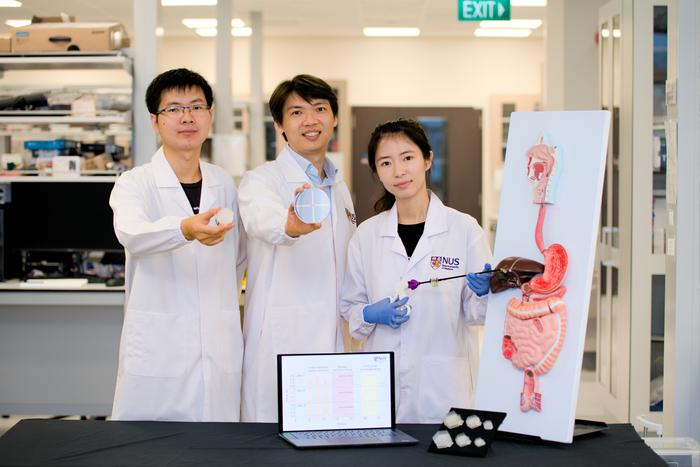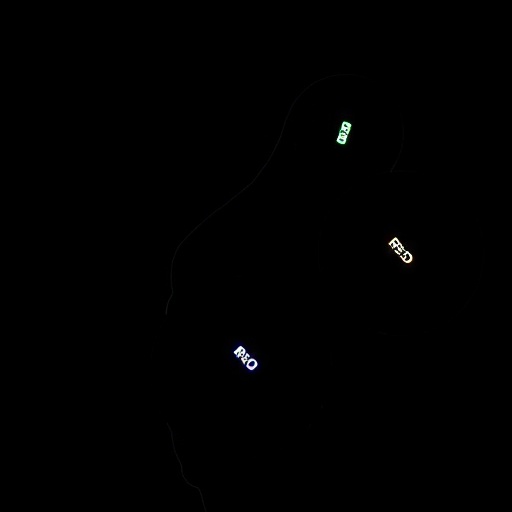Researchers at the National University of Singapore (NUS) have developed a novel aero-elastic pressure sensor, called ‘eAir’. This technology can be applied to minimally-invasive surgeries and implantable sensors by directly addressing the challenges associated with existing pressure sensors.

Credit: National University of Singapore
Researchers at the National University of Singapore (NUS) have developed a novel aero-elastic pressure sensor, called ‘eAir’. This technology can be applied to minimally-invasive surgeries and implantable sensors by directly addressing the challenges associated with existing pressure sensors.
The eAir sensor promises increased precision and reliability across medical applications. It can potentially transform laparoscopic surgeries by enabling tactile feedback for surgeons, allowing more precise manipulation of patient tissues. In addition, the sensor can improve patient experiences by offering a less invasive means of monitoring intracranial pressure (ICP), a key health metric for individuals with neurological conditions.
Led by Associate Professor Benjamin TEE from the NUS College of Design and Engineering and NUS Institute for Health Innovation & Technology, the research team’s findings were recently published in scientific journal Nature Materials on 17 August 2023.
From lotus leaf to laboratory: Harnessing nature’s design
Conventional pressure sensors frequently struggle with accuracy. They have trouble delivering consistent readings, often returning varying results when the same pressure is applied repeatedly and can overlook subtle changes in pressure — all of which can lead to significant errors. They are also typically made from stiff and mechanically inflexible materials.
To address these challenges in pressure sensing, the NUS team drew inspiration from a phenomenon known as the ‘lotus leaf effect’ — a unique natural phenomenon where water droplets effortlessly roll off the leaf’s surface, made possible by its minuscule, water-repelling structures. Mimicking this effect, the team has engineered a pressure sensor designed to significantly improve the sensing performance.
“The sensor, akin to a miniature ‘capacity meter’, can detect minute pressure changes — mirroring the sensitivity of a lotus leaf to the extremely light touch of a water droplet,” explained Assoc Prof Tee.
Employing an innovative ‘air spring’ design, the eAir sensor houses a trapped layer of air, forming an air-liquid interface upon contact with the sensor’s liquid. As external pressure increases, this air layer compresses. A surface treatment results in a frictionless movement of the interface within the sensor, triggering a change in electrical signals that accurately reflects the exerted pressure. Using this design, the natural water-repelling capabilities of the lotus leaf have been reimagined as a simple yet elegant pressure-sensing tool.
The eAir devices can be made relatively small – at a few millimetres in size – and this comparable to existing pressure sensors.
Potential game-changing advancement for minimally invasive surgeries
The real-world applications of this novel technology are wide-ranging. For instance, in laparoscopic surgeries where precise tactile feedback is indispensable, incorporating eAir sensors could lead to safer surgical procedures, ultimately enhancing patient recovery and prognosis.
“Conducting surgeries with graspers presents its unique challenges. Precise control and accurate perception of the forces applied are critical, but traditional tools can sometimes fall short, making surgeons rely heavily on experience, and even intuition. The introduction of soft and readily integrable eAir sensors, however, could be a game-changer,” said Assoc Prof Tee, who is also from the NUS Department of Materials Science and Engineering.
“When surgeons perform minimally-invasive surgery such as laparoscopic or robotic surgery, we can control the jaws of the graspers, but we are unable to feel what the end-effectors are grasping. Hence, surgeons have to rely on our sense of sight and years of experience to make a judgement call about critical information that our sense of touch could otherwise provide,” explained Dr KAAN Hung Leng, Consultant, Department of General Surgery at the National University Hospital, Ng Teng Fong General Hospital and NUS Yong Loo Lin School of Medicine.
Dr Kaan, who is not involved in the research project, elaborated, “The haptic or tactile feedback provided by smart pressure sensors has the potential to revolutionise the field of minimally-invasive surgery. For example, information about whether a tissue that is being grasped is hard, firm or soft provides an additional and important source of information to aid surgeons in making prudent decisions during a surgery. Ultimately, these intra-operative benefits have the potential to translate into improved surgical and patient outcomes.”
Additionally, eAir presents an opportunity to improve the process of monitoring intracranial pressure — the pressure within the skull that can influence brain health. Similarly, by offering a minimally invasive solution, the technology could transform patient experiences in the management of brain-related conditions, ranging from severe headaches to potential brain damage.
Unfolding the future of smart sensing
The NUS team is laying the groundwork for collaborations with key players in the medical field. At the same time, they have filed a patent for the eAir sensor technology in Singapore, and aims to translate the technology for real-world applications.
“We want to further refine the eAir sensor to enhance its performance by exploring various new materials and microstructural designs,” shared Assoc Prof Tee.
The team envisions the eAir technology being weaved into a diverse tapestry of applications for liquid environments.
Journal
Nature Materials
DOI
10.1038/s41563-023-01628-8
Article Title
Frictionless multiphasic interface for near-ideal aero-elastic pressure sensing
Article Publication Date
17-Aug-2023




